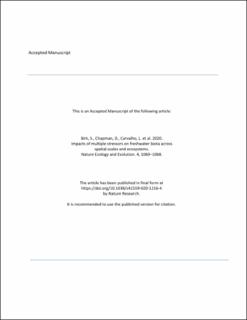| dc.contributor.author | Birk, Sebastian | |
| dc.contributor.author | Chapman, Daniel | |
| dc.contributor.author | Carvalho, Laurence | |
| dc.contributor.author | Spears, Bryan M. | |
| dc.contributor.author | Andersen, Hans Estrup | |
| dc.contributor.author | Argillier, Christine | |
| dc.contributor.author | Auer, Stefan | |
| dc.contributor.author | Baattrup-Pedersen, Annette | |
| dc.contributor.author | Banin, Lindsay | |
| dc.contributor.author | Beklioğlu, Meryem | |
| dc.contributor.author | Bondar-Kunze, Elisabeth | |
| dc.contributor.author | Borja, Angel | |
| dc.contributor.author | Branco, Paulo | |
| dc.contributor.author | Bucak, Tuba | |
| dc.contributor.author | Buijse, Anthonie D. | |
| dc.contributor.author | Cardoso, Ana Cristina | |
| dc.contributor.author | Couture, Raoul-Marie | |
| dc.contributor.author | Cremona, Fabien | |
| dc.contributor.author | de Zwart, Dick | |
| dc.contributor.author | Feld, Christian K. | |
| dc.contributor.author | Ferreira, M Teresa | |
| dc.contributor.author | Feuchtmayr, Heidrun | |
| dc.contributor.author | Gessner, Mark O. | |
| dc.contributor.author | Gieswein, Alexander | |
| dc.contributor.author | Globevnik, Lidija | |
| dc.contributor.author | Graeber, Daniel | |
| dc.contributor.author | Graf, Wolfram | |
| dc.contributor.author | Gutiérrez-Cánovas, Cayetano | |
| dc.contributor.author | Hanganu, Jenica | |
| dc.contributor.author | Işkın, Uğur | |
| dc.contributor.author | Jarvinen, Marko | |
| dc.contributor.author | Jeppesen, Erik | |
| dc.contributor.author | Kotamäki, Niina | |
| dc.contributor.author | Kuijper, Marijn | |
| dc.contributor.author | Lemm, Jan U | |
| dc.contributor.author | Lu, Shenglan | |
| dc.contributor.author | Solheim, Anne Lyche | |
| dc.contributor.author | Mischke, Ute | |
| dc.contributor.author | Moe, S. Jannicke | |
| dc.contributor.author | Nõges, Peeter | |
| dc.contributor.author | Nõges, Tiina | |
| dc.contributor.author | Ormerod, Steve J | |
| dc.contributor.author | Panagopoulos, Yiannis | |
| dc.contributor.author | Phillips, Geoff | |
| dc.contributor.author | Posthuma, Leo | |
| dc.contributor.author | Pouso, Sarai | |
| dc.contributor.author | Prudhomme, Christel | |
| dc.contributor.author | Rankinen, Katri | |
| dc.contributor.author | Rasmussen, Jes Jessen | |
| dc.contributor.author | Richardson, Jessica | |
| dc.contributor.author | Sagouis, Alban | |
| dc.contributor.author | Santos, Jose Maria | |
| dc.contributor.author | Schäfer, Ralf B | |
| dc.contributor.author | Schinegger, Rafaela | |
| dc.contributor.author | Schmutz, Stefan | |
| dc.contributor.author | Schneider, Susanne Claudia | |
| dc.contributor.author | Schülting, Lisa | |
| dc.contributor.author | Segurado, Pedro | |
| dc.contributor.author | Stefanidis, Kostas | |
| dc.contributor.author | Sures, Bernd | |
| dc.contributor.author | Thackeray, Stephen J. | |
| dc.contributor.author | Turunen, Jarno | |
| dc.contributor.author | Uyarra, María C. | |
| dc.contributor.author | Venohr, Markus | |
| dc.contributor.author | von der Ohe, Peter Carsten | |
| dc.contributor.author | Willby, Nigel | |
| dc.contributor.author | Hering, Daniel | |
| dc.date.accessioned | 2020-08-12T11:56:27Z | |
| dc.date.available | 2020-08-12T11:56:27Z | |
| dc.date.created | 2020-06-23T15:55:04Z | |
| dc.date.issued | 2020 | |
| dc.identifier.citation | Nature Ecology and Evolution. 2020, 4, 1060-1068. | en_US |
| dc.identifier.issn | 2397-334X | |
| dc.identifier.uri | https://hdl.handle.net/11250/2671753 | |
| dc.description | Embargo until 15 December 2020 | en_US |
| dc.description.abstract | Climate and land-use change drive a suite of stressors that shape ecosystems and interact to yield complex ecological responses (that is, additive, antagonistic and synergistic effects). We know little about the spatial scales relevant for the outcomes of such interactions and little about effect sizes. These knowledge gaps need to be filled to underpin future land management decisions or climate mitigation interventions for protecting and restoring freshwater ecosystems. This study combines data across scales from 33 mesocosm experiments with those from 14 river basins and 22 cross-basin studies in Europe, producing 174 combinations of paired-stressor effects on a biological response variable. Generalized linear models showed that only one of the two stressors had a significant effect in 39% of the analysed cases, 28% of the paired-stressor combinations resulted in additive effects and 33% resulted in interactive (antagonistic, synergistic, opposing or reversal) effects. For lakes, the frequencies of additive and interactive effects were similar for all spatial scales addressed, while for rivers these frequencies increased with scale. Nutrient enrichment was the overriding stressor for lakes, with effects generally exceeding those of secondary stressors. For rivers, the effects of nutrient enrichment were dependent on the specific stressor combination and biological response variable. These results vindicate the traditional focus of lake restoration and management on nutrient stress, while highlighting that river management requires more bespoke management solutions. | en_US |
| dc.language.iso | eng | en_US |
| dc.publisher | Nature Research | en_US |
| dc.title | Impacts of multiple stressors on freshwater biota across spatial scales and ecosystems | en_US |
| dc.type | Peer reviewed | en_US |
| dc.type | Journal article | en_US |
| dc.description.version | acceptedVersion | en_US |
| dc.source.pagenumber | 1060-1068 | en_US |
| dc.source.volume | 4 | en_US |
| dc.source.journal | Nature Ecology and Evolution | en_US |
| dc.identifier.doi | 10.1038/s41559-020-1216-4 | |
| dc.identifier.cristin | 1816843 | |
| dc.relation.project | EC/FP7/603378 | en_US |
| cristin.ispublished | true | |
| cristin.fulltext | postprint | |
| cristin.qualitycode | 1 | |
